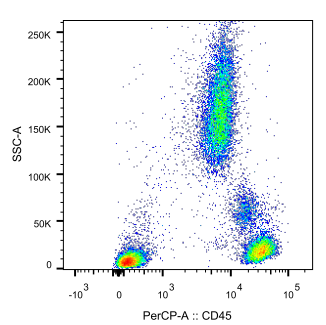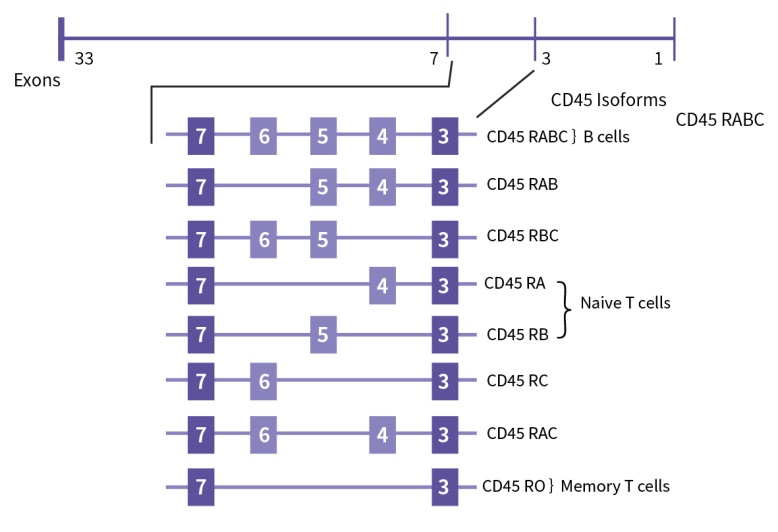| Name | Anti-Human CD45 antibody | |||
| Description | Mouse monoclonal antibody, cultured in vitro | |||
| Catalog # | K109h8 | |||
| Specification | 1xPBS,pH7.4 | |||
| Purity | Purity>98%, purified by Protein A/G chromatography | |||
| Storage | Aliquot and store at -80°C. Avoid freeze / thaw cycles. | |||
| Label | Peridinin-chlorophyll-protein complex (PerCP) | |||
Flow-cytometry platform
Whole blood samples were stained with CD45-PerCP antibody, and the expression of CD45 cells was analyzed by BD FACSCanto™ II flow cytometer. CD45 lymphocytes grouping were clearly observed.

Fig.1 Flow cytometry analysis of CD45 expression in immunocytes of human
(1)Cytoplasmic C-terminal: CD45 cytoplasmic domain is highly conserved, and the homologous structure accounts for 95% in mammals. This domain contains around 700 amino acid residues and consists of two protein tyrosine phosphatase (PTPase) domains with PTPase activity, in which, D1 is phosphatase active, while D2 interacts with D1 and alters their conformations to make the molecular structure of CD45 become more stable and active. The CD45 molecule can dephosphorylate the tyrosine on the substrate P56lck and P59fyn to activate them through the PTPase activity of the cytoplasmic region, which plays an important role in the transduction of cellular signal.
(2)Transmembrane region: Contains 22 amino acid residues.
(3)N-terminal region of extracellular glycosylation: The extracellular region contains about 400 amino acids, with 11-15 N-glycosylated sites and multiple O-glycosylated sites, and the entire domain presents a highly glycosylated status. Alternative splicing of the three exons encoding extracellular domains 4, 5 and 6 (or A, B and C) during transcription produces multiple isoforms, and CD45 isoforms are selectively expressed in different leukocytes and different stages of their differentiation. Meanwhile, with the differentiation and activation of cells, CD45 isoforms convert into each other. All CD45 isoforms can be classified into 4 specific monoclonal antibodies: CD45RA, CD45RB, CD45RC and CD45RO. CD45RA recognizes the epitope of exon 4 and exists on the surface of naive T cells. CD45RB recognizes the epitope of exon 5 and expresses it in B cells, naive T cells, thymocytes, macrophages and dendritic cells. CD45RB plays an important role in the signal transduction process of T cell receptor and B cell receptor. When naive T cells differentiate into memory T cells, the expression of CD45RB is down-regulated. CD45RO does not contain exons 4, 5, and 6 but mainly exists on the surface of activated or memory T cells.

Fig.2 Alternative splicing in the extracellular region of CD 45
